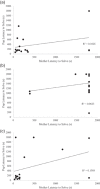Problem solving in fawn-footed mosaic-tailed rats Melomys cervinipes is not significantly influenced by maternal care or genetic effects
- PMID: 35754194
- PMCID: PMC9796929
- DOI: 10.1002/jez.2637
Problem solving in fawn-footed mosaic-tailed rats Melomys cervinipes is not significantly influenced by maternal care or genetic effects
Abstract
Innovative problem solving is thought to be a flexible trait that allows animals to adjust to changing or challenging environmental conditions. However, it is not known how problem solving develops during an animal's early life, or whether it may have a heritable component. We investigated whether maternal genetic and nongenetic effects influenced problem-solving ability in a native Australian rodent, the fawn-footed mosaic-tailed rat Melomys cervinipes. We measured direct (time spent grooming and huddling), indirect (time spent nesting), and total amount of maternal care received across pup development (postnatal Days 1-13). We measured problem solving in juveniles using matchbox tasks, and in mothers and adult offspring using six tasks of varying complexity (matchbox, cylinder, obstruction, pillar, tile, and lever tasks). We found no relationship between any maternal care measures and problem-solving abilities across multiple tests, suggesting limited (if any) maternal nongenetic effects. We also found that, as shown by low heritability estimates, problem solving only had a small heritable component in some tasks, but this was nonsignificant and requires further investigation. These results suggest that problem solving is unlikely to be constrained by maternal effects experienced during early development, and is, instead, more likely to be influenced by other factors (e.g., experience) later in an individual's lifetime.
Keywords: development; genetic effects; heritability; innovation; ontogeny.
© 2022 The Authors. Journal of Experimental Zoology Part A: Ecological Genetics and Physiology published by Wiley Periodicals LLC.
Conflict of interest statement
The authors declare no conflict of interest.
Figures




Similar articles
-
Innovation in a native Australian rodent, the fawn-footed mosaic-tailed rat (Melomys cervinipes).Anim Cogn. 2020 Mar;23(2):301-310. doi: 10.1007/s10071-019-01334-6. Epub 2019 Dec 3. Anim Cogn. 2020. PMID: 31797112
-
Both age and experience are important for successful problem solving in juvenile fawn-footed mosaic-tailed rats Melomys cervinipes.Anim Cogn. 2023 Jun;26(3):781-789. doi: 10.1007/s10071-022-01718-1. Epub 2022 Nov 18. Anim Cogn. 2023. PMID: 36401051
-
Memory enhances problem solving in the fawn-footed mosaic-tailed rat Melomys cervinipes.Anim Cogn. 2022 Apr;25(2):347-358. doi: 10.1007/s10071-021-01556-7. Epub 2021 Aug 28. Anim Cogn. 2022. PMID: 34453668
-
Innovation and problem solving: a review of common mechanisms.Behav Processes. 2014 Nov;109 Pt B:121-34. doi: 10.1016/j.beproc.2014.08.027. Epub 2014 Sep 19. Behav Processes. 2014. PMID: 25245306 Review.
-
Problem Solving in Animals: Proposal for an Ontogenetic Perspective.Animals (Basel). 2021 Mar 18;11(3):866. doi: 10.3390/ani11030866. Animals (Basel). 2021. PMID: 33803609 Free PMC article. Review.
References
-
- Barlow, G. W. (1991). Nature‐nurture and the debates surrounding ethology and sociobiology. American Zoologist, 31(2), 286–296.
-
- Bee, M. , Bernal, X. , Calisi, R. , Carere, C. , Carter, T. , Fuertbauer, L. , Ha, J. C. , Hubrecht, R. , Jennings, D. , Metcalfe, N. , Smith, II, A. , Sneddon, L. , & Vitale, A. (2020). Guidelines for the treatment of animals in behavioural research and teaching. Animal Behaviour, 159, i–xi.
-
- Van den Bergh, B. R. , Mulder, E. J. , Mennes, M. , & Glover, V. (2005). Antenatal maternal anxiety and stress and the neurobehavioural development of the fetus and child: links and possible mechanisms. A review. Neuroscience & Biobehavioral Reviews, 29(2), 237–258. - PubMed
-
- Blackenhorn, W. U. , & Perner, D. (1994). Heritability and repeatability of behavioural attributes affecting foraging success and fitness in water striders. Animal Behaviour, 48(1), 169–176.
-
- Bókony, V. , Pipoly, I. , Szabó, K. , Preiszner, B. , Vincze, E. , Papp, S. , Seress, G. , Hammer, T. , & Liker, A. (2017). Innovative females are more promiscuous in great tits (Parus major). Behavioral Ecology, 28(2), 579–588.
Publication types
MeSH terms
Grants and funding
LinkOut - more resources
Full Text Sources

